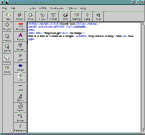| Linux users
who have spent time getting to know their systems will most probably have come to
appreciate the power of the shell as a command line interface. After a while, it becomes
difficult to imagine how a GUI could be of any significant assistance in manipulating the
vast collection of utilities and tools. However,
TkWorld manages to extend the shell into the GUI without seriously restricting it, and
provides a number of useful extra features.
At the top of the main window is a Command Center, which
allows you to type commands as if you were in a shell. To execute the commands, you click
on a lightning bolt icon in the main menu. The output is shown underneath in a Log Window,
with timestamps on the start and finish of the command output. This is very similar to
some of the query tools provided with commercial database products.
The cool part is that commands you have typed may be saved
as a shell script to be used again later from the command line, or via tkWorld. This is
great for testing and developing scripts.
The output of the Log
Window may also be saved, which can be useful for keeping a record of what you've been
doing.
Another feature, called the Registry, maintains detailed
information about common commands such as grep. These are listed in a window down the
left-hand side of the application. When a command is selected from the Registry, a
customised dialog box pops up with text entry fields for parameters and check-boxes for
common switches. Once you've decided how you want the utility to run, its command line
equivalent is copied to the Command Center, which may be further edited or integrated with
other commands via pipes and similar facilities.
It's probably best to have a look at the application to
really see what it can do. Installation is extremely simple, as it is coded in the
scripting language Tcl/Tk. You just need to ensure that Version 8 or higher of this
package is installed on your system.
Once up and running, TkWorld is easy to use. Leaving the
mouse over an icon will cause a tooltip to pop up, explaining its purpose, and HTML-based
help is available from within the application.
TkWorld is a very useful
package, and probably best suited to newer Linux users, although more experienced users
may be pleasantly surprised. It is definitely worth a look. |


